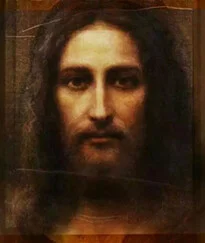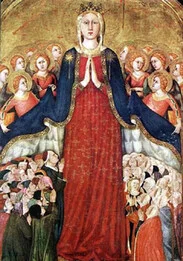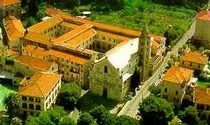the ring
Documents

THE RING
 The left hand of the Madonna di Pia in the painting by Nicolò da Voltri carries a mysterious ring on the middle finger.
The left hand of the Madonna di Pia in the painting by Nicolò da Voltri carries a mysterious ring on the middle finger.Its modest workmanship excludes that it is a jewel.
That ring is not even an occasional artistic whim of the painter, because he repeats it in the Madonna and Child in San Donato in Genoa:
it is intentional.
A ring on the left hand of a married woman is usually a sign of a commitment of fidelity to her duties as a bride
to her husband and as a mother to the family.
But such a ring is worn on the ring finger.
Why then does the painter insert it on the middle finger instead?
Because she is unique in the world: unique in the history of all humanity.
She is Bride and Mother and she is also a Virgin!
Mary in Nazareth, her childhood dreams, certainly had the face of her betrothed, Joseph.
A thrill of wind, moved as by a light beating of wings, a whisper that is barely heard, but clearly understood.
She, almost dreamy for what she had meant, said yes!
Everything dissolved except the profound joy of a girl who now knew she was a mother.
It was not the wind, but the breath of the Spirit that had touched her.
The joy, which now enveloped her, was so great that she almost ran over the mountains
(per montana, says the good old Latinorum) of Judea to Ain-Karin, to her cousin Elizabeth, to melt into the Magnificat.
Here's what that ring can tell us.
However, Mary is a very special Virgin because, while remaining such, she generates.
In fact, in the history of Christianity we have turned to Mary both as the Virgin and as the Mother.
Mary generated both physically and spiritually.
While remaining Virgin, Mary became physically
MOTHER OF JESUS.
 It is the substance, the teaching and the spiritual legacy that count, not the physical traits, it can be said, with good reason.
It is the substance, the teaching and the spiritual legacy that count, not the physical traits, it can be said, with good reason.Yet even the curiosity for the physical features of Jesus of Nazareth continues to animate studies and debates, polemics and misunderstandings. (Here above the Christ of the Shroud elaborated by NASA).
And we want to talk about it today, because as they say, the eye also wants its part.
I imagined it, you know? Several times ... And his face corresponded precisely to this Shroud face, with eyes that strike, so much is the power that they release!
Christ became incarnate in Jesus, Palestinian, Israelite (but what did that change, 2000 years ago?!)… He had an olive, dark, Mediterranean complexion… Like a common Syrian or Lebanese today. His eyes were between green and brown, only those who have seen him can understand how penetrating and powerful his eyes were!
Hair? Well, not light, of course, but dark brown ...
The representation of the blond Christ began to permeate European culture from the early Middle Ages onwards, not because of ethnic suprematism, but because the increasingly frequent appearance in the Mediterranean world of Nordic populations (who pull the blond) which more fashionable and interesting the blond. Well before the note of racism rang out tragically in the last century.
The Virgin Mary is spiritually as well

MOTHER OF THE CHURCH

Mother of the Church (Latin: Mater Ecclesiae) is a name that the Catholic Church uses to refer to Mary, the mother of Jesus.
Pope Paul VI recalled this title in his address to the last public session of the Second Vatican Council, on 7 December 1965:
«Imploramus auxilium Beatae Mariae Virginis, Matris Christi, quae a Nobis etiam Mater Ecclesiae est appellate. ("We ask for the help of the Blessed Virgin Mary, Mother of Christ, who is also called Mother of the Church by us") "
The pope himself had used the name in promulgating Lumen Gentium, a document of the same council on the Church.
On March 3, 2018, Pope Francis instituted the obligatory memory of Mary Mother of the Church, to be celebrated on the Monday after Pentecost.
The ancient painting (overflowing with ecclesiastics, nuns, crowned heads and angels) and the accompanying text (and which knows a lot of curial and juridical) fail to convey the beauty of the Church of which Mary is Mother.
I think that even a distracted reader might be more comfortable with a passage from the Seer of Patmos that resounded in our churches at the beginning of this month: ... And behold, an immense multitude, that no one could count, from every nation, tribe, people and language. All stood before the throne and before the Lamb, wrapped in white garments, and held palm branches in their hands. And they cried out in a loud voice: "Salvation belongs to our God, seated on the throne, and to the Lamb."
Here is the Church of which Mary is Mother!

